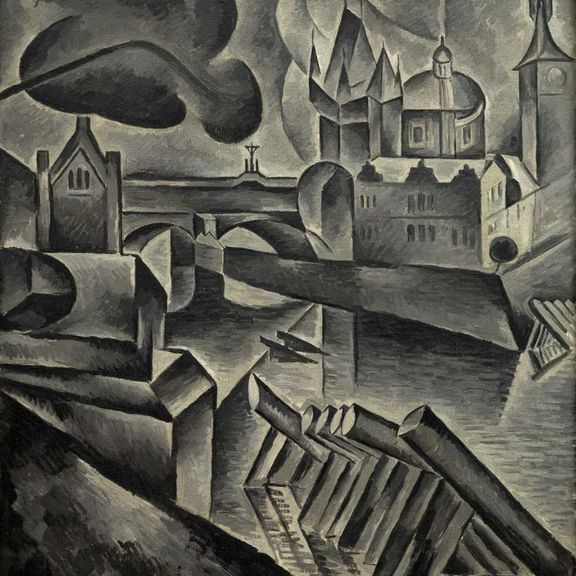
oil on canvas
1926
lower left
61.5 × 77 cm
frame
Half of the 1920s were marked by success in the life and work of one of the most important Czech modern painters, Václav Špála. In 1925, SVU Mánes organised a retrospective exhibition for his 40th birthday, which was such a great success that he subsequently received a scholarship worth 2,000 crowns for a stay in southern France. This stay likely became the initiation trigger of his so-called “blue period”. In France, Špála executed several Cézanne-style paintings, which were later seen by Czech critics as the pinnacle of his work to date. The Old Port of Marseille captures a lighthouse towering majestically above the sea, painted in brick and sometimes even vermilion red, which is also reflected in subtle accents on the prows and chimneys of the anchored ships in the background. However, the dominant tone is composed of three shades of blue: the turquoise blue surface of the sea, the stormy blue, almost violet mountains rising in the background, and the infinite blue of the summer sky. This remarkable painting from Špála’s stay in France is considered rare on the art market, thus presenting a unique opportunity for collectors. On the reverse of the painting is the number 123 in a circle, leading to the artist’s inventory, where it is listed on p. 47 under the title “Old tower at the entrance to the old port in Marseille”, and director Jan Neumann is recorded as its owner, as evidenced by the label on the stretcher. According to Špála’s notes, the painting was most likely exhibited at the members’ exhibition of SVU Mánes, where he presented his works from the south of France for the first time: The 100th exhibition of Mánes Association of Fine Artists 1926 (September–October 1926, cat. No. 245 or 246 – we do not know which of these two numbers exactly because Špála often changed the titles of his paintings). He also included it in his solo exhibition in 1935: Comprehensive exhibition of the works of Václav Špála (1 March – 10 April 1935), for which it had already been lent by its owner, Jan Neumann (cat. No. 78). The work was also reproduced in black and white in the artist’s first monograph, published as the seventh volume of the Musaion edition (1927). Assessed during consultations by PhDr J. Machalický and prof. J. Zemina. The expertise of PhDr. K. Srp is attached.







